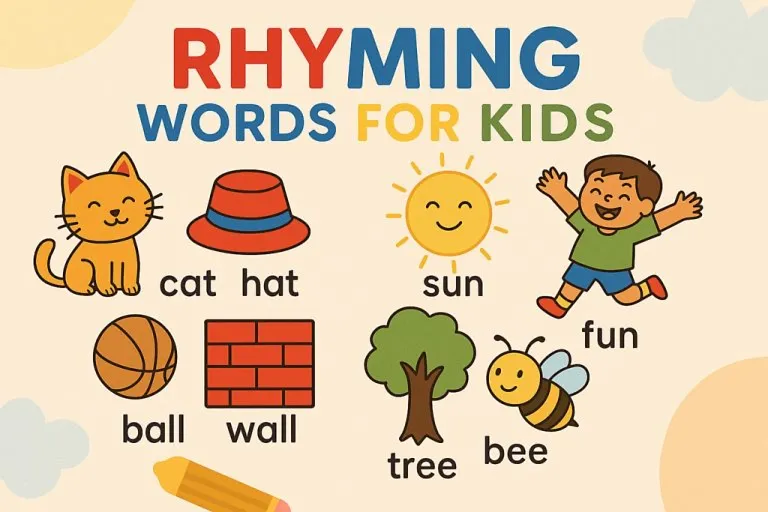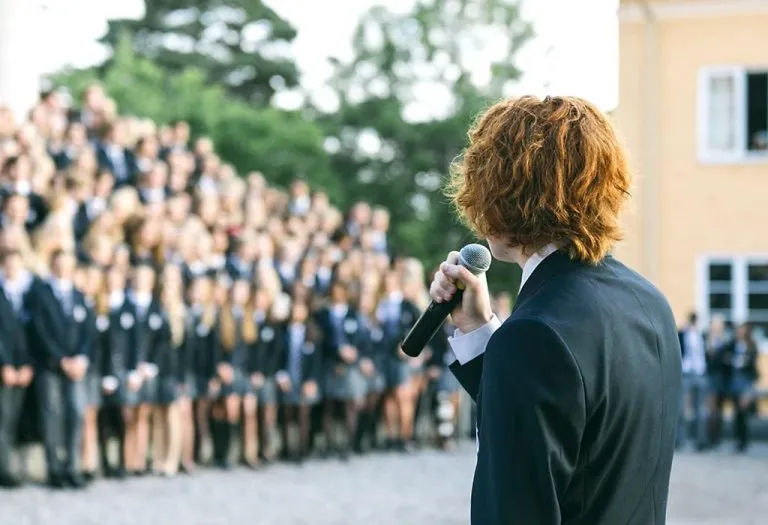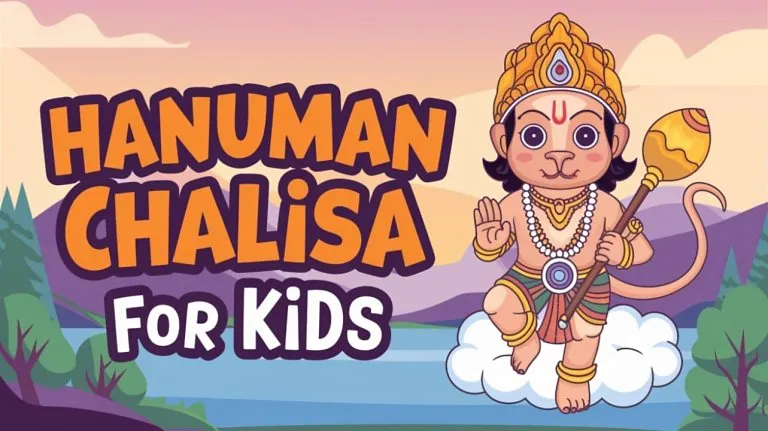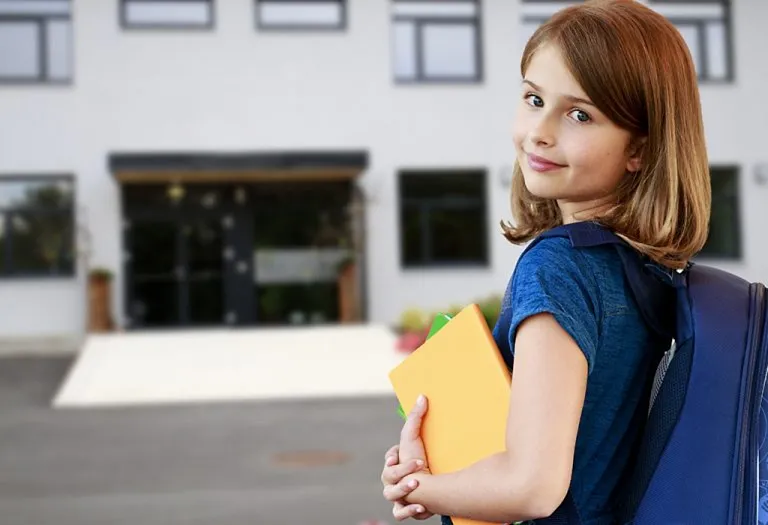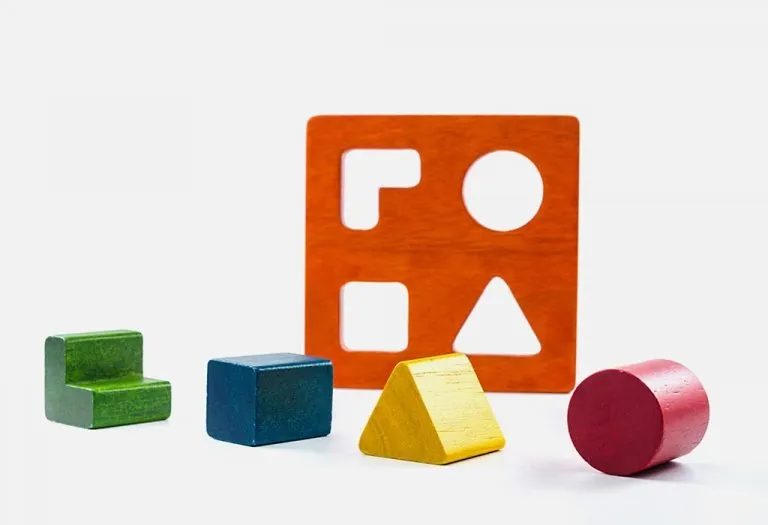Rhyming Words for Kids With Examples & Learning Activities
There’s something magical about the way children light up when they hear two words that sound alike. From nursery rhymes we hum to bedtime stories we share, rhyming words have a special way of capturing their attention. They’re playful, musical, and surprisingly powerful for language development. Think back to your own childhood—maybe you learned “cat” and “hat” before you could spell your full name. That’s because our brains love patterns, and rhymes create mini patterns in speech that kids can easily remember.
For little learners, rhyming isn’t just about fun. It’s a stepping stone to reading and writing. By noticing similar sounds, kids start understanding how words are built, making spelling less intimidating later on. Whether you’re a parent looking to make homework exciting or a teacher planning an engaging activity, exploring rhyming can be one of the simplest yet most effective ways to boost learning while keeping it joyful.
What Are Rhyming Words?
Rhyming words are words that have the same ending sound, like pat and hat or star and car. You can hear the rhyme when you say them aloud and notice how the ending matches. They make learning fun for kids and help them play with sounds in a natural way.
What Is the Typical Age for Kids to Learn Rhyming Words?
Most kids start to notice and enjoy rhyming sounds as early as 2 or 3 years old when they listen to songs and stories. By ages 3 to 4, many children can recognise which words rhyme, like knowing “cat” and “bat” sound alike. Around kindergarten age, usually 5 years old, kids can often create their own rhymes and play with rhyming words confidently. This natural progression helps build important skills for reading and language.
What Are the Benefits of Teaching Rhyming Words to Kids?
Teaching rhyming words helps kids enjoy language and builds important skills for reading and speaking. It improves their ability to hear and play with sounds, which makes learning to read easier later on. Rhymes also boost memory, thinking skills, and creativity, all while making learning fun and engaging for young children.
List of Rhyming Words for Kindergarten
Preschool rhyming words are a wonderful way to introduce young children to the joy of language. These simple word pairs help kids notice sounds and patterns while making learning playful and fun. Here’s a list of common words along with some easy rhymes to get started.
| WORD | Rhymes With |
| CAT | Bat, Hat, Mat, Rat |
| DOG | Log, Fog, Bog, Hog |
| SUN | Fun, Run, Bun, Gun |
| PEN | Hen, Ten, Men, When |
| BIG | Pig, Wig, Dig, Fig |
| CUP | Pup, Up, Sup |
| TREE | Bee, See, Free, Knee |
| FAN | Man, Ran, Can, Pan |
| BALLOON | Soon, Noon, Spoon, Tune |
| RED | Bed, Fed, Led, Shed |
| BOX | Fox, Ox, Locks, Rocks |
| JET | Net, Wet, Bet, Pet |
| STAR | Car, Far, Bar, Jar |
| FISH | Dish, Wish, Swish, Mish |
| BAT | Rat, Sat, Mat, Cat |
| DUCK | Truck, Luck, Muck, Stuck |
| BELL | Shell, Well, Tell, Sell |
| MUG | Rug, Tug, Bug, Hug |
| BOOK | Hook, Shook, Nook, Look |
| CHAIR | Hair, Fair, Pair, Bear |
| KING | Ring, Wing, Sing, Thing |
| LAMP |
Camp, Ramp, Stamp, Champ
|
| MOON | Spoon, Boon, Tune, June |
| BALL | Tall, Fall, Call, Mall |
| BIRD | Word, Curd, Heard, Third |
| CARROT | Parrot, Ferret, Barrett |
| DOOR | Floor, Shore, More, Roar |
| EGG | Leg, Peg, Beg, Meg |
| FEET |
Meet, Greet, Sheet, Sweet
|
| GOAT | Coat, Boat, Moat, Throat |
| HOUSE |
Mouse, Spouse, Louse, Douse
|
| ICE | Rice, Mice, Slice, Nice |
| JAM | Ham, Sam, Cam, Clam |
| KEY | Sea, Me, Free, Bee |
| LIGHT | Kite, White, Bright, Night |
| NOSE |
Rose, Shows, Toes, Clothes
|
| OWL | Towel, Howl, Foul, Growl |
| PANTS |
Ants, Rants, Plants, Grants
|
| QUEEN |
Green, Seen, Screen, Marine
|
| RING | Sing, Wing, King, Bing |
| SNOW | Blow, Show, Glow, Flow |
| HAND | Sand, Land, Band, Grand |
| VAN | Can, Man, Fan, Ran |
| WATER | Daughter, Hotter, Potter |
| X-RAY | Play, Say, Stay, Day |
| EIGHT | Skate, Mate, Date, Late |
| HILL | Will, Kill, Fill, Mill |
| COOK | Look, Hook, Book, Took |
| SIX | Sticks, Mix, Fix, Tricks |
| TRAIN | Rain, Mane, Brain, Plain |
These preschool rhyming words are perfect for kindergarten activities, helping children to hear and play with sounds naturally. Using them in games, songs, or simple reading exercises makes learning both enjoyable and effective. Encourage kids to try making their own rhymes with these word pairs to build confidence and creativity with language.
Rhyming Words for Kindergarten Classes 1, 2, and 3
As children move from preschool into early school years, they continue to grow their understanding of sounds and words. Rhyming words for classes 1, 2, and 3 help kids build vocabulary, improve reading fluency, and enjoy playing with language. Using a rhyming words list A to Z is a great way to keep learning fresh and fun with new words that sound alike.
Here is a list of rhyming words suitable for kindergarten and early primary classes, focusing on pairs and groups not covered earlier. These can be used in classrooms or at home for practice and creative rhyming activities.
| WORD | Rhymes With |
| BAD |
Mad, Sad, Glad, Pad
|
| DIG |
Fig, Big, Wig, Pig
|
| CAP |
Map, Nap, Lap, Tap
|
| PAT |
Cat, Hat, Mat, Rat
|
| RAN |
Can, Man, Fan, Pan
|
| FIT | Sit, Bit, Hit, Kit |
| NET |
Bet, Jet, Get, Wet
|
| HOP |
Top, Mop, Pop, Shop
|
| JUG |
Rug, Bug, Tug, Mug
|
| LEG |
Peg, Beg, Egg, Meg
|
| MAD |
Sad, Bad, Glad, Had
|
| NUT |
Cut, Gut, Hut, Strut
|
| PIN |
Win, Tin, Bin, Thin
|
| RIP | Lip, Dip, Zip, Sip |
| SAD |
Mad, Bad, Glad, Dad
|
| TAP |
Map, Cap, Lap, Nap
|
| VET |
Get, Let, Net, Set
|
| WET |
Bet, Net, Pet, Jet
|
| WIN |
Pin, Tin, Bin, Spin
|
| ZIP |
Sip, Lip, Dip, Rip
|
| BAKE |
Cake, Lake, Make, Take
|
| CAKE |
Bake, Lake, Make, Take
|
| MAKE |
Bake, Cake, Lake, Take
|
| LAKE |
Bake, Cake, Make, Take
|
| PLANE |
Cane, Lane, Mane, Lane
|
| CANE |
Plane, Lane, Mane, Sane
|
| MANE |
Plane, Cane, Lane, Vane
|
| FROG | Log, Jog, Cog, Hog |
| RAIN |
Train, Brain, Strain, Plain
|
| STRAIN |
Train, Brain, Rain, Plain
|
| PLAIN |
Train, Brain, Rain, Strain
|
| SHIP |
Dip, Lip, Rip, Zip
|
| DIP | Lip, Rip, Sip, Zip |
| SIP |
Lip, Dip, Rip, Zip
|
| HIP |
Lip, Sip, Dip, Rip
|
| TENT | Rent, Sent, Bent, Lent |
| NIGHT |
Light, Right, Fight, Tight
|
| RIGHT |
Light, Night, Fight, Tight
|
| TIGHT |
Light, Night, Right, Fight
|
| BEAR |
Care, Share, Dare, Glare
|
| CARE |
Share, Bear, Dare, Glare
|
These rhyming words for classes 1, 2, and 3 can enhance reading lessons and inspire kids to create their own rhymes. Using a rhyming words list A to Z helps teachers and parents cover a wide range of sounds in a structured but fun way. Encourage children to use these words in sentences, stories, or poems to deepen their understanding and love of language. This natural play with sounds builds essential literacy skills while keeping learning joyful and memorable.
Rhyming Words Activities for Children
Getting children to play with words that sound alike is a fun and effective way to build their language skills. Children’s rhyming words activities create a playful space where kids can listen, think, and talk about sounds while having a great time. These easy rhyme words activities are simple to set up and keep children engaged with learning through movement, games, and creativity.
1. Rhyming Names Game
Make a circle and play a game where children listen for rhymes with their own names. For example, say a made-up rhyme like “If your name rhymes with Sam, clap your hands.” Kids love hearing their names turned into rhymes, and it makes the learning personal and fun.
2. Rhyming Hopscotch
Draw a hopscotch grid on the floor and write simple words in each square. As kids hop, they say a word that rhymes with the one they land on. This combines physical activity with rhyming practice, perfect for active learners.
3. Rhyming Story Time
Read a story with rhyming words and pause to let children guess or say the next rhyming word. This helps kids listen carefully and think about sounds in words while enjoying a story together.
4. Rhyme Matching Cards
Create pairs of cards with rhyming words or pictures and have children find and match them. This helps develop memory skills and makes recognising rhymes a hands-on experience.
5. Rhyming Word Hunt
Hide cards or objects with rhyming words around the room or outside. Children hunt for pairs of rhyming words or pictures to collect. This fun searching game keeps kids moving and thinking about rhymes.
6. Silly Rhyming Voices
Say rhyming words in silly voices like a whisper, a robot, or a funny character. Children then repeat the words the same way. This playfulness makes rhyming words exciting and silly, which encourages kids to practice without pressure.
7. Rhyme and Move Obstacle Course
Set up a simple obstacle course with pictures or cards of rhyming words attached to each station. Kids move through the course saying a rhyming word each time they reach a new spot, blending learning with physical play.
8. Rhyming Word Families Tree
Draw a big tree on paper and write a word ending like “-at” on the trunk. Help kids come up with words that rhyme and write them as leaves. This visual activity shows how many words share the same sound and makes rhyming easy to understand.
FAQs
1. What are some common 3-letter rhyming words for kids?
3-letter rhyming words are great for young learners because they are short and easy to say. Examples include words like “bug,” “jug,” “mug,” “hip,” “lip,” and “dip.” These simple words help children hear and play with sounds, making rhyming fun and accessible right from the start.
2. Can you give examples of four-letter rhyming words that kids can use?
Four-letter rhyming words add a fun challenge while still being easy enough for kids to remember. Some common examples are “cake,” “bake,” “lake,” “make,” and “take.” These words are perfect for creating little stories or rhymes that flow smoothly and keep children engaged with language.
3. What are action rhyming words, and how can they help children learn?
Action rhyming words are words that rhyme with each other and include reaction, traction, faction, and action. Using these words in songs and games helps children connect language with bodily movements, thereby creating an exciting and interactive learning experience. This kind of rhyming also strengthens memory and speech skills by linking sounds with motions naturally.
Here is nearly everything on rhyming as one of the simplest and most enjoyable ways to associate children with language. It makes learning light and fun, where the child spontaneously starts to notice sounds and patterns in words. A number of activities, including rhymes in songs, stories, and games, or just lists of rhyming words, ensure that children have a great start in reading and speaking. Rhyming helps to enhance memory, stimulate creative thinking, and make learning more interesting each day. A mix of simple activities with well-chosen words will help parents and teachers create a permanent base for children’s language skills. Given regularity in practice, rhyming becomes more than amusement: it transforms into the basic instrument for effective communication.
Also Read:
Rhyming Riddles For Kids To Boost Their Creativity
Best Educational Songs, Rhymes & Music for Kids
5 Fun Ideas To Teach Kids To Rhyme Words and Sounds
Was This Article Helpful?
Parenting is a huge responsibility, for you as a caregiver, but also for us as a parenting content platform. We understand that and take our responsibility of creating credible content seriously. FirstCry Parenting articles are written and published only after extensive research using factually sound references to deliver quality content that is accurate, validated by experts, and completely reliable. To understand how we go about creating content that is credible, read our editorial policy here.





